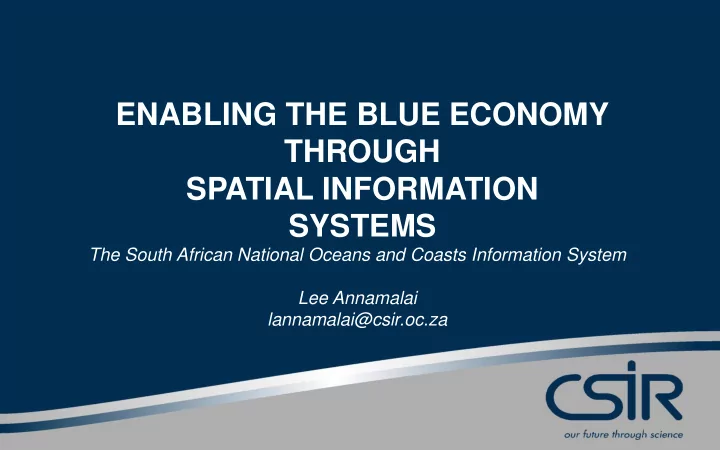

ENABLING THE BLUE ECONOMY THROUGH SPATIAL INFORMATION SYSTEMS The South African National Oceans and Coasts Information System Lee Annamalai lannamalai@csir.oc.za
Phakisa Vision Environmentally Sustainable & Responsible Growth Oceans Economy is part of the Nine Point Plan launched by President J Zuma in February 2015, for Growing the South African Economy South Africa’s ocean economic potential ranges between R129 and R177bn by 2033*, with between 800 000 to 1 million jobs* created Projected GDP contribution and job potential were determined, reflecting economic realities at the time with certain underlying assumptions 2
Phaksia Focus areas 3
Sector Values and Economic Goals South Africa’s ocean economic potential ranges between R129 and R177 bn by 2033, with between 800 000 to 1 mn jobs created 4
South Africa Oceans Challenge Land Size: 1.2 million km 2 Exclusive Economic Zone (EEZ) Size: Land Mass 1.5 million km 2 EEZ Extended Continental Shelf Claim 5
South Africa Oceans Challenge 6
Ocean Observations Introduction More and More … data is processed and represented in some form of map, however the pace and change in the real-world requires enhanced processing to provide real- time and real-world context to the observations. The South African shelf seas, the South Atlantic, Indian and Southern Oceans are a vast, remote and in some places inhospitable domain. Effective governance requires the availability of a broad range of information for this large, remote and rapidly changing area. Satellites are the only way of quickly and routinely providing such information
Ocean Observations strategic view • Monitoring of the Southern Oceans, in the 1.3m Km² that form the SA EEZ, has been a concentrated effort for many years though not systematically or co-ordinated • A range of remote sensing analytics and in-situ measurements are performed regularly, though not yet operationally in the oceans around the South African coastline and in the oceans between South Africa and the Antarctic • Localised Mature and demonstrable solutions exist for • Monitoring Marine and Coastal ecosystems • Operational Maritime Domain Awareness (ship traffic, pollution, security) • Understanding the Oceans role in the Carbon Cycle • Observing the biological and biogeochemical marine and freshwater ecosystems
Decision Support Value Chain underpinned by operational linked sensing and modelling systems CYBERSPACE VALUE TO END USERS DeSTs Decision Support Tools SENSING in THE REAL WORLD 9 9
Ocean Observations strategic view
EO/Spatial Data Advanced SDI Analytics User Experience HABs MPA Alerting Hazard lines Environmental Variables Near Shore Ops at sea Vessel Tracking Geo-Spatial Oily Bilge Processing Platform detection SDI Media Data Repository Monitoring Security OCIMS and SEAFAR
Early Benefit Assessment 2015 2016 2017 Annual contribution to GDP: R200M Annual contribution to EC GDP: R500 M Annual contribution to GDP: R1.02 Bn Retail Price: ~US$38-42/kg Retail Price: ~US$1200/ton Retail Price: ~US$1200/ton Economic value of Event: R114M Economic Effect of 2016 Event: R70M Economic Effect of 2017 Evnt: R70-R140M 200 tons 57% of annual GDP contribution 14% of annual GDP contribution 10% of annual GDP contribution
Protecting the fishing industry Annual contribution to Provincial GDP: $50 Million Retail Price: ~US$3000/ton • Vessels detected in SA EEZ using AIS Economic Effect of 2016 Event: $2M 4% of annual GDP contribution • Remote Sensing analytics flagged the vessels as being unauthorised and violating RSA regulations • AIS Spoofing • No fishing permits • Radio interaction with Ship led to them turning AIS off and trying to flee SA EEZ • SAR data used to detect Dark targets in the area • Spatial Notification System fed locations to intercept vessel 13
Tracking Illegal Fishing 14
AI Detection of Vessels 10/06 – 12/07 10 Total number of dark vessels (no AIS) detected within the Marion Island EEZ Marion Island is a declared special nature conservation park and Sovereign South African Territory 15
Preserving the Rock Lobster Annual cont to GDP: $20M Retail Price: ~US$38-42/kg • Remote Sensing algorithms using a Economic value of Event: $11.4M 57% of annual GDP cont fused product of Sea Surface Temperature, Met Data and Ocean Color • Routine ingest of satellite data and local processing • Automated spatial notification system constantly forecasts for intercepts between the HABs and Marine Spatial Plans to determine risk levels • Alerts sent to end users eg Aquaculture (fish farms), Env Protection Agencies, Local Municipalities 16
Preventing Economic loss to Aquaculture 17
Automated Bilge Dump Detection 18
Integrated Maritime Products Multi-Sensor Monitoring of Environment and Security 1.� ± 30� km� long� slick� 2.� Path� of� pollu ng� detected� 20:40� 21 st � vessel� Salvage� Champion� February� by� ASAR� sensor� from� AIS� data� Integration of Synthetic Aperture Radar, AVISO, Ocean Colour and 3.� ± 30� km� long� slick� detected� AIS vessel identification data in a 22 nd � 07:49� February� by� MERIS� Google Earth environment for a sensor,� ± � 8km� downstream� from� ini al� loca on� maritime pollution incident example 19
ZACUBE-2 – Nano Satellite • 3U platform • Launch Q1/2018 • Flexible Software Defined Radio to enable connectivity M2M • SDR will allow reception of AIS message and will be VDES capable • Medium resolution imager Funding from DST and SANSA acknowledged.
SOME OF THE OCIMS PARTNERS 21
Africa – 38 Coastal States. AU Integrated Maritime Strategy 2050 – Estimates $1 Trillion/annum 22
Scale Up Towards achieving the Africa Blue Economy Supported by GMES-Africa co-designed decision-making services to promote sustainable management of marine resources, improve marine governance, and stimulate growth of the blue economy in the South and East African regions
Recommend
More recommend